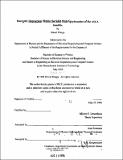Energetic interactions within the solid-state spectrometer of the ASCA Satellite
Author(s)
Wangu, Srimal
DownloadFull printable version (2.925Mb)
Other Contributors
Massachusetts Institute of Technology. Dept. of Physics.
Advisor
Mildred S. Dresselhaus.
Terms of use
Metadata
Show full item recordAbstract
ASCA is a broad band (0.3 - 12 keV) x-ray astrophysical observatory in which various instruments operate with high throughput and high spectral resolution. Detailed examination of the method in which photoelectronic interactions occur in the Charge Coupled Devices (CCDs) of the Solid-State Imaging Spectrometer (SIS) on ASCA reveals a sudden variation in the nearly linear CCD signal output versus energy input curve near the silicon K-edge. The focus of this thesis is the modeling of the behavior of the SIS CCD at the silicon K-edge, first by theoretical analysis, and then by analysis of X-ray spectral data already acquired from the instrument. The relationship between CCD signal out and incoming photon energy at the silicon K-edge in the ASCA detectors is studied in detail in order to define and analyze the behavior of the CCD in this range. The results from this study showed that theoretically, a one to two percent deviation between incoming energy and output pulse-height should exist in the CCD. Although the nonlinearity was consistent with the available data, insufficient signal-to-noise in this data restricted the definite quantification of this disparity.
Description
Thesis (M.Eng. and B.S.)--Massachusetts Institute of Technology, Dept. of Electrical Engineering and Computer Science; and, (B.S.)--Massachusetts Institute of Technology, Dept. of Physics, 1995. Includes bibliographical references (p. 82-84).
Date issued
1995Department
Massachusetts Institute of Technology. Department of Electrical Engineering and Computer Science; Massachusetts Institute of Technology. Department of PhysicsPublisher
Massachusetts Institute of Technology
Keywords
Electrical Engineering and Computer Science., Physics.